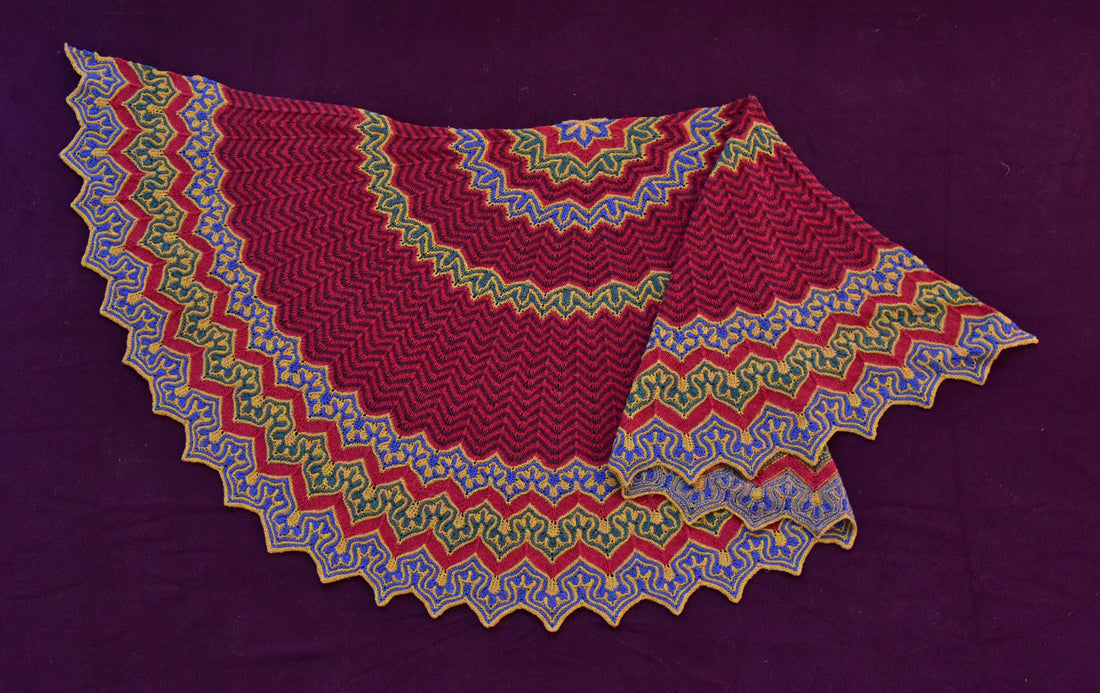Cast On the Hard Project

When taking on a new technique, many knitting teachers will tell you to start slow and easy. But for my adventurous students, challenging projects tend to lead to greater success and mastery of the technique. There are a few reasons why this can happen, sometimes people get bored of simple projects. Other times, the best project for learning isn't going to be the most stylish. In this blog post, I'll share a few of the reasons why complicated knitting patterns tend to be more motivating and help you find out if you're the type of knitter who would benefit from taking on more challenges as you learn.
We've all been there, you see a sweater in a store window or a sample at the shop, and you simply have to make it. Every single time, it's a project with some sort of obscure, difficult technique that you've never tried before. Do you immediately cast on the difficult project, or do you start from the beginning, looking at a simple craft tutorial or a beginner level project to help you learn the new skills?
Avoid the Dull Stuff
Learning should be fun. When you take on a new skill as part of your knitting journey, it helps to work on something that you actually want to make. Avoid the beginner level patterns if they don't interest you. If they do, that's great, you're going to have a good time making that simple project and you'll get a lot of use out of it. But oftentimes, the most intriguing patterns are a little more complex. If you're drawn in by one of these challenging knits, go for it, take the adventurous approach.
By taking on difficult patterns, knitters enhance their problem-solving skills, boost their creativity, and build new skills within the context of a real pattern. The sense of accomplishment that comes from completing a challenging project is incredibly rewarding and motivates knitters to finish complex projects with a much higher success rate than their overly cautious counterparts. The satisfaction of overcoming obstacles, mastering new techniques, and creating something beautiful with your own hands is truly unparalleled.
Are you an Adventurous Knitter?
The answer depends on your outlook on crafting. In my experience, their two categories of knitters: The first category is cautious and meticulous. They make a point of working on each see each new skill, building up from the basics. They believe a solid foundation will set them up for success when tackling more advanced projects, but they are spending a lot of time, yarn, and energy working their way up to the big project.
The second type of beginner tends to show up enthusiastically asking if they can try the hardest patterns I've ever designed. These knitters approach challenging patterns with determination and a willingness to learn. They break down the pattern into manageable sections, taking it one step at a time and taking advantage of video tutorials and online resources. By staying patient and persistent, they can conquer even the most daunting projects and harrowing stitches.
These beginners who take on the full challenge are often highly motivated by the end goal. they've committed to learning whatever techniques the pattern throws their way. Their mindset of optimism and desire leads to better results from the project.
Tips for taking on the challenge
Challenging knitting projects can be time-consuming and require a great deal of patience. It's important to approach the project with a positive mindset and be prepared to make mistakes along the way. Remember, knitting is a learning process, and each mistake is an opportunity to improve your skills.
Prepare mentally:
- Believe in your abilities. You already know that you can knit anything with your own two hands. A difficult project may give you some trouble. When it does, just remember that you've tackled many difficult things over the years, and this is no different.
- Temper your expectations. If you expect everything to go perfectly, but then you make a bunch of mistakes, it's not going to feel good. If you embark on the pject with the assumption that you'll make mistakes, it's a pleasant surprise when if don't happen and no big deal when if do.
- Stay calm and open minded. This tip is particularly important for experienced crafters. If you're scared of the stitches, the pattern's going to be a lot harder for you. If you encounter an intimidating instruction, don't get nervous. Try it as written, then get help if it doesn't go as expected. In most cases, those intimidating techniques aren't as scary as you think.
Take your time:
- Read through the entire pattern before you cast on. You'll get an idea of the construction and what stitches you need to know. You'll also get a little preview of the areas and the pattern that may be difficult. You don't need to be able to visualize everything that's happening, or even understand it, the read-through is just to give you a heads up so there are no surprises.
- Break the pattern into small, bite size pieces. Focus on one task at a time as you work your way through the pattern. Very often, a difficult stitch pattern is just a bunch of simple things put together in a more complex configuration. When you break the instructions down into their components, they're less intimidating and often much easier to understand.
- When you encounter something something new or confusing, isolate that set of instructions and move through them slowly. You can even cast on a swatch to practice the new technique outside of its context within the pattern.
- Set reasonable goals for yourself. Don't try to rush through something when you know it's going to be a challenge. If you do have a deadline, make sure that you add extra time just in case you make a mistake and have to rip back or need to go slow through some sections of the pattern.
Find help and community in an LYS, forum, or craft group:
- Use online resources to help you through. Some patterns will have their own online resources like video lessons, but older patterns will not. It shouldn't discourage you from diving in. There are many video resources for knitting techniques online, and they are also communities where you can get help. If you get stuck in a pattern, consider posting on Ravelry for help or join my discord community to get help from a friendly group of crafters.
- Find local community if you can. Join a knitting group. If you're lucky, there will be a friendly, helpful group of people in your area who get together and knit. Environments like this are great places to get help from your peers in person.
- If you have access to a local yarn shop, they'll often be able to provide help as well. One good reason to shop at a n LYS and not a chain or online store is because the yarn shop is also there to provide support. Let them know what pattern you're working on and that it's a challenge. Very often there will be an employee in the shop. Who has the experience to help you with that difficult technique if you get stuck
If you're an experienced knitter and you're not used to encountering new stitches anymore, it can be jarring when you finally take on a project that involves learning. Just remember that, even though you have lots of experience, you can still be a beginner at some techniques. Whenever I take on something new, I get frustrated that it's taking longer or that it's more difficult than something I'm an expert at already. Sometimes this feeling discourages me from taking on a challenge. I have to remind myself that there will be some discomfort anytime I try to grow my skill set as a knitter, but it's worth the extra effort to add a new skill to my repertoire.
So, the next time you see a knitter working on a complex pattern, remember that they are not just knitting; they are embarking on a journey of growth and self-improvement. Embrace the challenge, take on the hard project, and who knows, you might discover a new passion for pushing your own boundaries in the world of knitting.









4 comments
Thank you for this. I am an experienced knitter who loves color, asymmetry, and new ideas, like your throw the dice pattern. But in order to improve my skills, I have been doing the Professional Knitters certification course of the American Knitting Guild. I feel like I am in a straightjacket. There is no joy. And you explained why!
Love this
I get very bored by simple knits and they take me forever (pure stockinette sweaters I won’t do)
I do believe that well written instructions make a huge difference in embarking on complex projects. As well as good video tutorials. :-)
Great advice! I always learn more when I knit beyond my comfort zone and learning to fix those mistakes is just as valuable!
Love